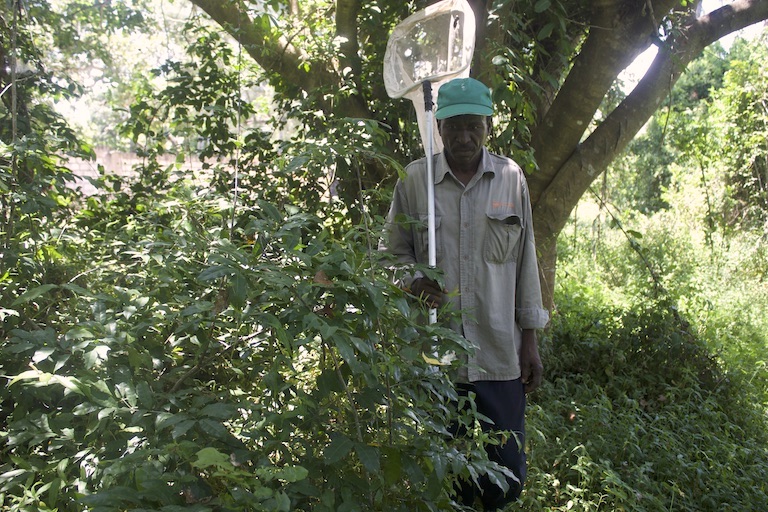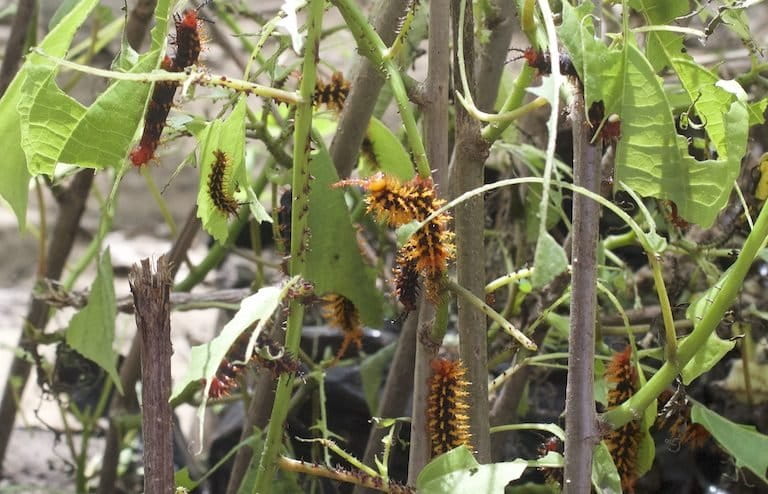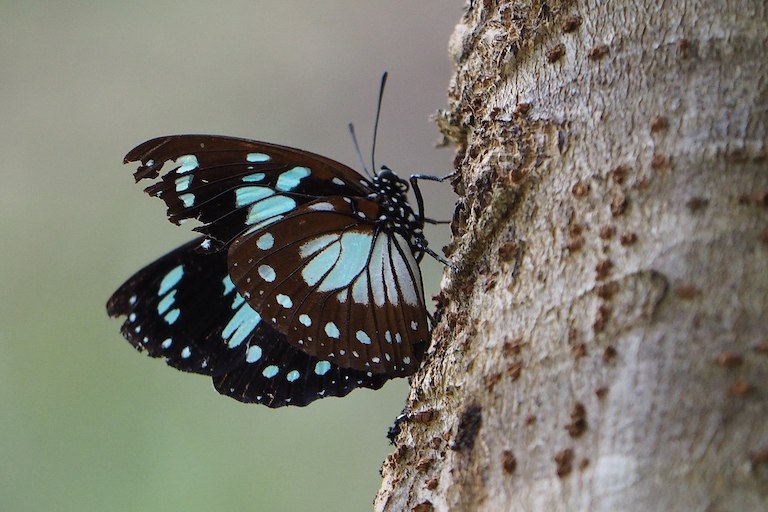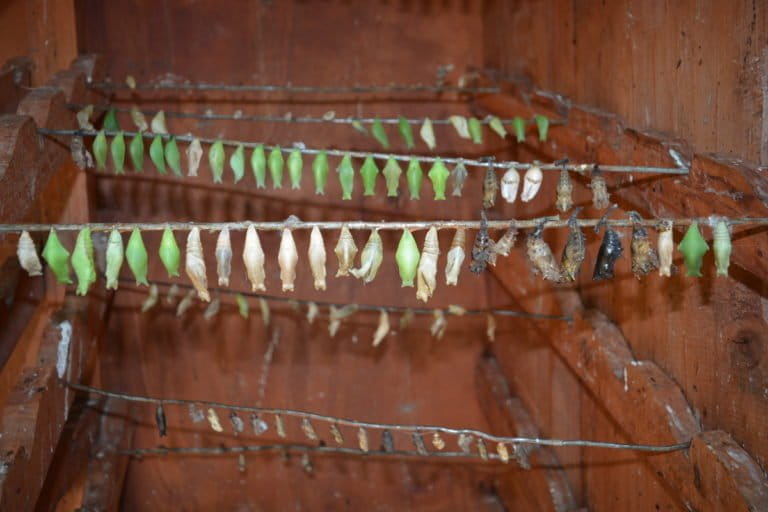- As many as 1,200 people living around the forests of coastal Kenya and Tanzania have turned to butterfly farming to make a living. Many of them were once loggers who now defend the forest.
- Three butterfly-farming initiatives aim to conserve forests while generating sustainable incomes for local communities by raising and selling pupae to research institutes and butterfly houses in Europe and Turkey.
- The most successful of the initiatives is helping to conserve the 420 square-kilometer (162 square-mile) Arabuko-Sokoke Forest Reserve in Kilifi county, Kenya, the last large remnant of a forest that once stretched from southern Somalia to northern Mozambique.
- By contrast, the two Tanzanian projects are currently challenged by a government ban on wildlife exports.
KILIFI COUNTY, Kenya — If 51-year-old Hillary Thoya were to choose a lucky number, it would surely be 5,000. That’s the amount, in Kenyan shillings, the logger and carpenter turned butterfly farmer paid to secure his freedom a decade ago. And it was the same amount that assured him his newfound venture could actually sustain his family at a time when he was considering giving up.
One afternoon in 2008, Thoya was arrested by Kenya Forest Service (KFS) officers inside Arabuko-Sokoke Forest Reserve in Kenya’s Kilifi county, accused of illegally felling trees. Thoya wasn’t too concerned; he knew a small bribe would quickly secure his release and he could get back to the job of completing construction of a sunbed for a customer.
However, luck wasn’t on Thoya’s side. Earlier that month new forest officers had been dispatched to the region precisely to curb instances of bribery.
“As I was trying to negotiate for my freedom, the officer kept telling me ‘OK, OK, but let’s go discuss that in the office,’ and as soon as I got into their vehicle they drove me into the compound of a police station,” Thoya recalled.
He spent four days at the police station before his brother-in-law came to his rescue, coughing up a fine of 5,000 shillings ($50).
Thoya spent two more years dodging KFS officers in the forest before he finally stopped logging illegally and learned to farm butterflies instead, as part of the Kipepeo Butterfly Project. Today, Thoya is one of hundreds of butterfly farmers who are active champions for the protection of Arabuko-Sokoke forest.

With a smile on his face, he recently recounted the first big payment he received from his farming-group chair, which convinced him he’d made the right career move.
“I was wondering if I had made the wrong decision since I was earning approximately 500 [shillings, $5] a week. But when she sent me 5,000 on mobile money transfer I almost thought she had confused my payment with that of another farmer,” Thoya said.
Thoya’s story is common around the forests of coastal Kenya and Tanzania. Many residents, including Thoya, are members of the indigenous Mijikenda ethnic group. And like him, many have ditched illegal logging or hunting to participate in butterfly farming initiatives: Kipepeo Butterfly Project in Kenya or the Amani Butterfly Project or Zanzibar Butterfly Centre in Tanzania. As many as 1,200 farmers have participated in recent years, with Kipepeo, which is focused on Arabuko-Sokoke forest, carrying the largest number at 878.
During peak season, from March to September, Thoya doubled his luck and now earns up to 10,000 shillings each week.
Thoya said the work enabled him to set up a fish-selling business for his wife, who previously didn’t work outside the home. Together they’ve been able to educate their 10 children, some through vocational institutes.

The business of butterflies
At his family compound in Magangani village, about 8 kilometers (5 miles) from the Indian Ocean resort town of Watamu, Thoya sliced a rotting mango and sprinkled its juice on a net. He was preparing to trap his next batch of butterflies.
The current group, mostly variable diadems (Hypolimnas anthedon) in the caterpillar stage, was locked up in a netted cage outside Thoya’s house. He was waiting for them to transition into pupae so he could sell them to Kipepeo. From there they would be sent abroad to spend the rest of their lives in a butterfly house in the United Kingdom, perhaps, or Turkey.
Thoya said he wasn’t expecting much from the current batch; the brown-and-white variable diadems, rather plain by butterfly standards, sell for a mere 20 shillings (20 cents) a pupae. But he was optimistic that his next batch would include more colorful, and hence marketable, butterflies like flame-bordered charaxeses (Charaxes protoclea), stunners in black and crimson.
At the Arabuko-Sokoke Forest Reserve entrance, Thoya showed his pass to a forest officer, who signaled him to proceed into the forest.
Kipepeo is managed by the National Museums of Kenya and partners with other government agencies, including KFS and the Kenya Wildlife Service, and helps finance the farmers to start up.
“When I decided to venture into butterfly farming, I did not have any money. But after training, the project team gave me this catching net and constructed the rearing shed for me,” Thoya said as he configured his net into a funnel shape on a tree branch.
An unlucky white-and-black butterfly fell right into the net as its cohorts flitted off the branch and away. Thoya explained that the fermented mango juice attracts the butterflies, but once they feed on it the ethanol it contains makes them woozy and unable to fly.
After repeating the process on 10 trees, Thoya’s net was a scene of colorful butterflies. He was pleased by his luck: among the catch was an African swallowtail (Papilio dardanus), a.k.a. the flying handkerchief, one of the most highly priced species, at 80 shillings (80 cents) per pupae.

Thoya would bring it and the rest back home to live in a netted cage. With more luck, they would lay eggs on the orange plants inside. The eggs would hatch into caterpillars, and the caterpillars would transition to pupae he could sell to Kipepeo about three weeks after he’d trapped the parents in the forest.
“Initially I did not join because I was interested in conservation. I was just looking for an income-generating method that would not get me in trouble with the authorities,” Thoya said. “But eventually, as time went by, I realized that I can benefit from the forest and leave it intact for my children and grandchildren, who may want to benefit too.”
The farmers are divided into groups. Thoya belongs to the Magangani farming group, which is chaired by 43-year-old Mwaka Juma, the one who sent him his first lucky 5,000-shilling paycheck, a housewife turned butterfly farmer.
When Mongabay visited Juma at her house in Magangani village, she proudly showed off a sewing business she said she’d financed with butterfly money.
During the peak season, Thoya and the other farmers in the group hand over their pupae to Juma, who travels on Fridays and Mondays about 4 kilometers (2.5 miles) to Kipepeo in the town of Gede to sell her group’s produce.

Other chairpersons, like 36-year-old Dickson Mbogo of the Mkongani farmers’ group, have farther to travel. Mbogo and most of his group members live about 40 kilometers (25 miles) away from the butterfly center.
Mbogo, another former logger and charcoal trader, started farming butterflies in 2006. He said the venture helped him construct a permanent house and educate his two sisters.
“Whenever I walk back into the same forest without having to play hide-and-seek with forest officers I feel very good,” he told Mongabay. “And when I meet my former associates I try to dissuade them to stop cutting down those trees because they are putting their future generations at risk.”

Once the pupae reach Kipepeo headquarters, workers sort them according to species and health before sending them on their journey abroad. Kipepeo currently exports up to a million pupae annually to Turkey, the U.K. and Germany. According to Hussein Aden, Kipepeo’s manager, most of the butterflies are displayed in butterfly houses while some are used for research at universities and butterfly centers and others are fashioned into home décor.
The group sells colorful species like the silver-striped charaxes (Charaxes lasti) for a minimum of $2.50 a pupae, including shipping. Less colorful species like the African migrant (Catopsilia florella) sell for $1 a pupae.
According to Aden, the farmers’ collecting of wild butterflies doesn’t harm the populations, whose biggest threat is habitat loss. And maintaining a continuous supply of farm-raised butterflies would not be feasible, he said, because demand for particular species is irregular.

Butterflies as forest ambassadors
Butterfly farming is relatively new to the Mijikenda of coastal Kenya; their major traditional economic activities include fishing, farming and charcoal trading. According to Aden, Kipepeo was started in 1993 to provide an alternative and sustainable income for the 100,000 or so people living near Arabuko-Sokoke forest.
At approximately 420 square kilometers (162 square miles), Arabuko-Sokoke is the largest patch left of a coastal forest that once stretched from southern Somalia to northern Mozambique. Today mostly small patches, known as Kayas and protected by local Mijikenda elders, remain.
Arabuko-Sokoke is one of the only known habitats for the golden-rumped elephant shrew (Rhynchocyon chrysopygus), which sections of the local community consider a delicacy despite its being listed as endangered. About 300 butterfly species live there, out of the 871 found in Kenya.
Only 74 butterfly species, all with IUCN status of “least concern,” have been approved for farming. Customers wanting an endangered species like the Taita blue-banded swallowtail (Papilio desmondi teita) must make a special order, and the species is only available during the rainy season.

The newfound appreciation for butterflies and the forest they inhabit has spread beyond butterfly farmers, according to Aden. Since the project launched 25 years ago, he said, local communities have stopped viewing the forest as wasted farmland.
According to Nicholas Munyao, KFS’s coast region ecosystem conservator, the project is good for butterflies because it results in the protection of their habitats. And these, of course, are home to numerous other species in a variety of taxa.
“I would not say logging is not taking place in the forest,” Munyao said. “[But] it has gradually reduced, and you find that most of [the loggers] are not from the local community.”
Overtime, Kipepeo has expanded to include other forests, such as Kakamega in western Kenya, Taita Hills in the southwest, and Shimba Hills in the southeast.

To spread the conservation message among Kenyans and Tanzanians, the butterfly farming enterprises have set up butterfly houses similar to those buying their pupae. In Kenya, there’s Kipepeo’s in Gede and the Mombasa Butterfly House in Mombasa; both Tanzanian ventures, the Amani Butterfly Project in Shebomeza village and the Zanzibar Butterfly Centre on Zanzibar Island, have exhibits at their headquarters. Species on display include the red spot diadem (Hypolimnas usambara), a black-and-white butterfly with traces of yellow on its tail; the forest queen (Euxanthe wakefieldi), a brown butterfly with patches of sky blue; and Thoya’s favorite, the blue-spotted emperor (Charaxes cithaeron).
The initiatives’ success in promoting conservation has not gone unnoticed; in 2011 the Zanzibar Butterfly Centre, which aims to conserve Jozani Chakwa Bay National Park, received a SEED Award for Entrepreneurship in Sustainable Development from the U.N. And this fall Kipepeo hosted the 20thannual conference of the International Association of Butterfly Exhibitors and Suppliers, whose mission focuses heavily on butterfly conservation — the first time the conference was held in Africa.

Trouble in Tanzania
In addition to the successes, the butterfly projects have also faced challenges. In Kenya, difficulties include failing to meet the huge demand during the high season, and producing a surplus during the low seasons.
In Tanzania, though, the challenges are bigger, the biggest being the government’s banning of wildlife exports. First came a one-year ban in 2011, after alarming reports of animal smuggling the previous year. Then in 2016, the government issued a three-year ban to give it time to draft a permanent policy that would seal legal loopholes.
Amir Saidi, project manager at the Amani Butterfly Project, said the bans have slashed revenues and sent most of the 150 farmers Amani was supporting in search of alternative work.
“From 2003 to 2015 we were doing quite well,” he said. “With the ban in place we are [now] only relying on the butterfly house as a source of income, but you cannot compare the revenue generated from the butterfly house with that that was there when we were doing pupae exports.”
The Zanzibar Butterfly Centre has also ceased exporting and is now only running a butterfly house.
This March will mark the end of the three-year ban. By then Saidi said he hopes the government will have finished crafting a new export policy that will give consideration to butterfly farmers. Amani, he said, had proven beneficial in conserving forests in the East Usambara Mountains, home to a number of endemic species such as the critically endangered long-billed forest warbler (Artisornis moreaui). The ban curtailed the Amani project before staff could study how it affected the community’s use of the forest, Saidi said, but he had noticed positive changes.

Butterfly farmers speak up for the forest
Kenya’s deforestation problem is far bigger than what butterfly farming could ever address. The country lost more than 9 percent of its tree cover, equivalent to 3,100 square kilometers (almost 1,200 square miles) between 2001 and 2017, according to Global Forest Watch.
A scathing report released last April by a special task force that the environment ministry formed to investigate the country’s alarming loss of forest decried “rampant corruption and abuse of office” within KFS, resulting in widespread illegal logging.
The report led to more complaints, including allegations that a KFS officer was involved in an illegal logging racket operating in Arabuko-Sokoke. Before the release of the report, the community living near the forest had pushed for the officer’s transfer and the relocation of his office from the town of Kilifi, 33 kilometers (20 miles) from the forest, to nearby Gede, where Kipepeo is based, so the agency could keep a closer eye of the forest.

According to Abbas Shariff, chairman of the Arabuko-Sokoke Forest Dwellers Association, which promotes protection of the forest, such activism would not have been possible without the butterfly projects, which have helped the community see the importance of the forest.
“Unlike several years ago, we know that once you start messing with this forest, you are messing with our livelihood and that of our future generations,” Shariff said. “That’s why you see us dealing with anyone trying to mess us up.”

Banner image: A blue pansy (Junonia orithya), a species occasionally available through Kipepeo Butterfly Project. Image by yakovlev.alexey via Flickr (CC BY-SA 2.0).
